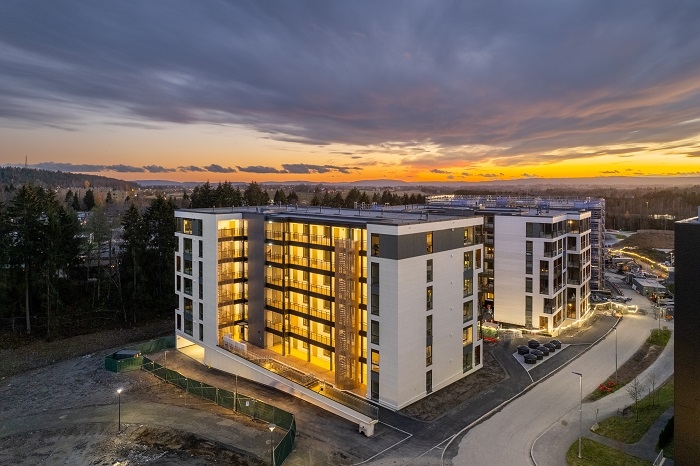Companies in the Estonian wooden house sector are optimistic about the future despite the economic challenges faced in 2024 due to low foreign demand, which is expected to continue in 2025. Annika Kadaja, CEO of Woodhouse Estonia, noted that this optimism is driven by the increasing demand for wooden construction that aligns with European climate goals. This trend presents a new growth opportunity for Estonian companies and supports the sector’s ambition to achieve a billion-euro export turnover.
“The sector’s positive outlook is driven by increased demand for wooden construction and sustainable, energy-efficient solutions—exactly what Estonian house factories provide, in line with Europe’s climate goals,” stated Annika Kadaja.
Strategies for the construction sector have either been developed or are currently in progress in the target countries. These include methods for calculating and accounting for the carbon footprint in construction, requirements for utilising local raw materials, energy consumption targets, and a national renovation strategy. “At the same time, there is also a strong housing shortage in markets such as Germany, the Netherlands and Ireland,” Kadaja mentioned, which is a growth opportunity for companies in the sector.
Estonian wooden sector companies export to more than 100 countries in total. Scandinavian countries, Sweden and Norway, remain among the priority target markets. “Companies continue actively seeking cooperation opportunities to maintain their position in these markets. Given the greater emphasis of the construction sector in these countries on wooden construction, sustainable solutions, and established cooperation with our house factories and partners, a recovery in market demand could be possible,” Kadaja was optimistic.
However, in recent years, companies have increasingly turned their attention to Western Europe: Germany, the Netherlands, Great Britain, Denmark and Ireland. “For instance, Kodumaja is working on a 137-room hotel for the Danish market. This project represents the first time in over 13 years that the company has taken on a project in Denmark,” Kadaja gave an example.

Ambition to increase export turnover to a billion
Although demand in the mentioned markets is high due to the lack of housing, according to Kadaja, these markets (except Germany) are not sufficiently ready. “This means that there is no experience and culture of wooden construction at all or it is low, the awareness of factory buildings is low, and there are various regulatory challenges. If these regulatory issues can be addressed in the near future, then the sector’s export turnover of one billion euros is not a lofty goal but a springboard for even more global business,” she confirmed.
Approximately 2,000 new workers are needed to achieve the sector’s export turnover goal of one billion euros. According to Kadaja, companies have established the Woodhouse Academy to address the shortage of qualified labour, which is worsened by increasing labour costs. “Despite the current challenges in the sector, we remain optimistic and believe that investing in workforce engagement and training is crucial to our long-term growth strategy,” said Kadaja.
According to Kadaja, the construction sector is transforming to align with the European Union’s green goals, creating favourable opportunities for industrial construction. “The ambition of the Woodhouse Academy is to offer additional training and learning opportunities through an interactive learning platform for almost all job positions in the sector, from woodhouse builders to architects and developers,” explained Kadaja.
Unfortunately, According to Kadaja, the current decline in the sector has been significant, that in 2025, companies will primarily focus on restoring volumes and exploring new markets. “Diversifying export markets will help reduce dependence on one or two key markets, which have historically been Sweden and Norway. Therefore, if the share of new markets in total exports increases, the sector will discover growth opportunities.”
Product development is in full swing
Kadaja remarked that during this challenging economic period, companies in the Estonian wooden house sector have focused on improving efficiency, which involves activities that support growth simultaneously. “We are seeing new, promising success stories being born – several research projects developing the field are in the works, such as Drastic and 5G Timber.”
Product development is also actively pursued in factory renovation and patenting construction solutions. A notable example is a pilot project focused on renovating 19 apartment buildings. Through this initiative, the factories successfully developed facade element solutions, leading to advancements in modern renovation innovations.
“In 2025, companies will emphasise investments that promote product development and the training and engagement of qualified labour. They are actively working on new solutions, including modular concepts, to enhance the industrialisation of construction and improve efficiency in both new builds and renovation projects,” Kadaja stated.
At the same time, the emphasis is on applying circular economy principles through research projects. These principles are expected to become essential in the construction industry, providing a competitive edge over traditional construction in producing factory-built houses and designing wooden buildings.
GOOD TO KNOW
- For over 10 years, Estonia has been Europe’s largest exporter of prefabricated wooden houses, exporting as much as 90-95% of its production.
- The sector’s export capacity is over 500 million euros (540 million euros in 2022).
- The Estonian wooden house sector can produce practically every type of building: modular houses, element houses, and traditional log houses. In addition to private houses, smaller summer houses, and saunas, the companies’ product portfolios include large apartment buildings and public building projects.
- Outstanding examples of wooden house projects produced in Estonian house factories include the complex facade and roof elements of the Helsinki Central Library Oodi and the 14-story wooden building Treet in Bergen, Norway. In addition, Estonian wooden house manufacturers have built schools, kindergartens, apartment buildings, and more in Scandinavia and across Europe.
- The Estonian wooden house sector is among the most certified in Europe: It has the most European Technical Approval (ETA) certificates, which allow products to be given CE markings.Source: Woodhouse Estonia
Author and source: Signe Sillasoo, Trade with Estonia (EIS), January 2025